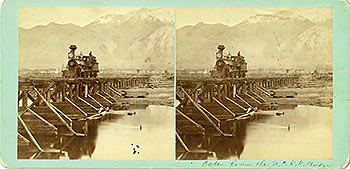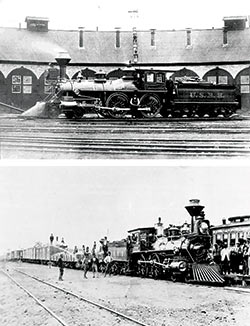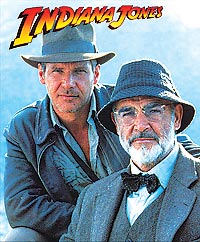by Moab Museum Staff
 |
| Utah Central Railroad engine on bridge over the Weber River, circa 1870. C.R. Savage Stereo-view. From USU Special Collections, Merrill-Cazier Library, P0038. |
It was May 10, 1869 when the Golden Spike was driven into the rail at Promontory Summit, Utah, signaling the completion of a railroad spanning North America. Imagine laying tracks from the east to west coasts of the United States with only mid-19th century tools and explosives to get the job done. The grand idea of linking the two coasts was one fraught with challenges from the start, but it was a vision that forever changed movement and migration across the United States. The undertaking would eventually reduce the time it took to cross the continent from months to mere days. The Pacific Railway Acts of 1862, signed into law by Abraham Lincoln on July 1, 1862, provided the funding and land necessary to begin the momentous project. Out of the new law, the impossible would become a reality: the building of the Transcontinental Railroad.
This important account of Utah and national history is now on exhibit at the Moab Museum through Autumn 2021, with two collections on loan from the Utah Division of Arts and Museums’ Traveling Exhibit Program. The stories are told through
 |
| Above: Utah Southern Railroad in Nephi, 1870s. From the Collections of the Utah State Historical Society. Below: Utah Southern Railroad roundhouse in Salt Lake City, circa 1880. From the Collections of the Utah State Historical Society. |
photos, maps, lithographs, objects, and narrative collected by a variety of historical institutions across Utah.
A World Transformed:The Transcontinental Railroad in Utah examines the historical events surrounding the completion of the transcontinental railroad in Utah between 1865 and 1875. Integrated with this exhibit, Through Toil and Labor: The Forgotten History of Utah’s Chinese Railroad Workers covers the important and often overlooked and unrecognized importance of Chinese laborers.
These two inseparable stories document a country enamored by the push toward westward expansion. They examine the exploitation of workers and indigenous tribes, the investors and business moguls who financed the massive project, and the determination of the Central Pacific Railroad (from the west) and the Union Pacific Railroad (from the east) to join in a race to lay track that would inevitably connect somewhere in the country’s middle. With many players jockeying for control of this massive project, the stakes were high and rife with corruption, legal loopholes, fraud, and deceit. In spite of the obstacles and brutal working conditions, it was the more than 10,000 Chinese workers hired by the Central Pacific Railroad that took on and completed most of the work. While a Chinese labor crew could lay 10 miles of track a day (a record that still holds), they suffered lower pay, extremely dangerous working conditions, racial discrimination, and were denied the path to U.S. citizenship. Their labor was essential not only to the railroad’s completion but in the building of America.
The Moab Museum is honored to host special exhibits that bring regional history to life, connecting our local history to state and nation-wide historic events.
The Museum is open Tuesday through Saturday from noon to 8:00 pm during the summer months. Visit the website for more information, and consider becoming a member. When you join the Moab Museum at any membership level, you directly support the preservation of the region’s cultural and natural history. Members empower the Moab Museum to grow, inspire, and serve the community now and for future generations.
118 East Center Street, Moab — 435-259-7985 — moabmuseum.org
 Red Cliffs Lodge, on the banks of the mighty Colorado River, is home to the Moab Museum of Film & Western Heritage. The lodge is built on the old George White Ranch, a key location for nine of the big westerns including Rio Grande, Cheyenne Autumn, Ten Who Dared, The Commancheros, and Rio Conchos.
Red Cliffs Lodge, on the banks of the mighty Colorado River, is home to the Moab Museum of Film & Western Heritage. The lodge is built on the old George White Ranch, a key location for nine of the big westerns including Rio Grande, Cheyenne Autumn, Ten Who Dared, The Commancheros, and Rio Conchos.
The late George White was founder of the Moab to Monument Valley Film Commission, the longest ongoing film commission in the world.
In the museum one can learn more about film locations, how the sets are built, and how the filming process is managed on nature’s own sound stage. On display in the museum are production photographs, movie posters, autographed scripts, props from the many pictures filmed in the area, and displays about the western ranching heritage. For information, call Red Cliffs Lodge at 435-259-2002.
 Through the magnificent landscapes of southeastern Utah, writers have been inspired and stories born here. Zane Grey, the famous western novelist, traveled through the area in 1912. His visit inspired him to write his book Riders of the Purple Sage. The book was made into a movie starring Ed Harris and Amy Madigan, and filmed on locations around Moab.
Through the magnificent landscapes of southeastern Utah, writers have been inspired and stories born here. Zane Grey, the famous western novelist, traveled through the area in 1912. His visit inspired him to write his book Riders of the Purple Sage. The book was made into a movie starring Ed Harris and Amy Madigan, and filmed on locations around Moab.
| A partial list of stars that have made movies in Moab John Wayne, Maureen O'Hara, Henry Fonda, Lee Marvin, Rock Hudson, Jimmy Stewart, Richard Boone, Anthony Quinn, Mickey Rooney, Shirley Temple, Kris Kristofferson, Billy Crystal, Robert Duvall, Gene Hackman, Bill Murray, Jack Palance, Susan Sarandon, Geena Davis, Ted Danson, Tom Cruise, and many more. |